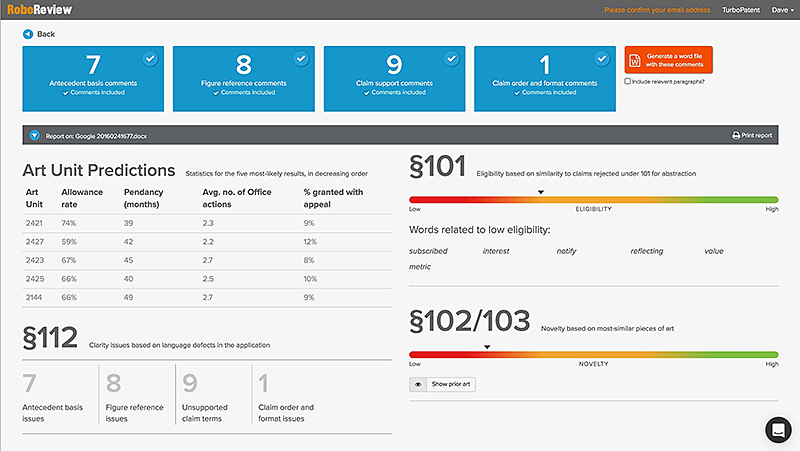Paralegal robot reviews patent documents
New software helps patent lawyers draft applications that are more likely to pass muster with the U.S. Patent and Trademark office, as well as respond to official letters from examiners.
TurboPatent Corp. on June 28 launched artificial-intelligence products that compare patent claims with past applications to make predictions about patent eligibility.
The patent drafting software, dubbed RoboReview, automates paralegal work, bringing more rigor to the task of researching prior art and potentially saving thousands of dollars on a filing. It’s sold as a subscription product on an unlimited or per-use basis.
“Typically this review is done by humans doing multiple searches,” says James Billmaier, TurboPatent’s chief executive officer. “Very seasoned attorneys are amazed at things the machine finds that they miss in these very technically written documents.”
The company also uses artificial intelligence in a product enhancement to help lawyers write responses to the examiner letters known as office actions.
Patent applicants must respond to the letter’s objections about patent claims’ viability. A product called SmartShell creates a properly formatted response, and the new feature, RapidResponse, generates text to submit the amended patent claims.
“For every argument we can measure statistics for what’s happened in prior applications,” says David Billmaier, James Billmaier’s brother and the company’s product vice president.

Just as litigation research tools track judges’ rulings, the software predicts how receptive a patent examiner would be to arguments about the eligibility, novelty or precision of a patent claim. A computer-generated report marks up a Word document with underline and strike-through edits that address examiner concerns.
Charles Mirho, chief legal counsel and a former attorney for Intel Corp., says machine learning has progressed beyond making word-for-word comparisons.
“This is not literally matching strings of text, but evaluating when two things mean the same thing using different language” Mirho says. “Before, a spot reviewer was needed to find semantically similar ideas. Now, bots compare descriptions that are conceptually similar but not using the same terminology.”
White the tools are geared toward U.S. regulators, their use extends to preparing foreign applications for U.S. review.
“What artificial technology is doing to a lot of repeatable functions, we’re just applying to a very large vertical,” David Billmaier says. “The attorney is still fundamental at working with the inventor and grabbing the idea. The machine is better at creating and protecting the application.” He draws a parallel between patent law and architecture, pointing out how CAD (computer assisted drawing) tools changed the profession for the better so that architects were no longer reliant, solely, on a pencil and drafting table. “We strongly believe patent law firms are going to look very different in the next five years, and those that don’t use AI are going to look way behind the curve,” he says.
TurboPatent raised $1.4 million this spring from private investors, bolstering a 2015 seed funding round led by Voyager Capital. Founded in 2008, the Seattle software company, until recently, was known as Patent Navigation.



